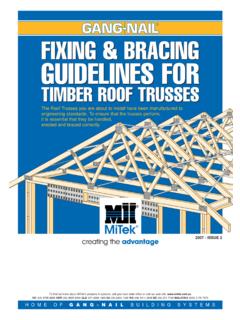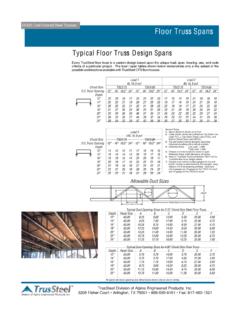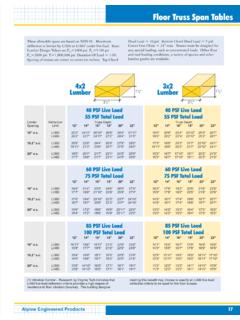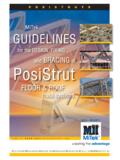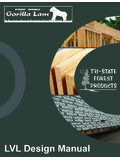Transcription of GUIDELINES FOR THE DESIGN FIXING & BRACING …
1 HOME OF GANG-NAILBUILDING SYSTEMSTo find out more about MiTek s products & systems, call your local state office or visit our web site: (03) 8795 8888 NSW (02) 8525 8000 QLD (07) 3268 1666 SA (08) 8234 1326 WA(08) 9411 2845 NZ(09) 274 7109 MALAYSIA(603) 3176 7473 GUIDELINES FOR THE DESIGNFIXING & BRACING OF Posi-STRUTFLOOR & ROOFTRUSS SYSTEMSGUIDELINES FOR THE DESIGNFIXING & BRACING OF Posi-STRUTFLOOR & ROOFTRUSS SYSTEMSJANUARY 20072 TABLE OF CONTENTSPosi-STRUT floor Truss SystemIntroductionAdvantagesDefinitionsF loor StiffnessFloor LoadingSpan Charts for Bottom Chord SupportSpan Charts for Top Chord SupportSupporting StructureHandling and StorageSet Out and PlacementTrimming On SiteSupporting External WallsSupported Non-Load Bearing WallsSupport DetailsFixing and
2 ConnectionsStrongbacksStair OpeningsCantileversBracingMechanical ServicesPosi-STRUT Roof Rafter & Purlin SystemIntroductionDefinitionRoof Loading/CamberSet OutSizesHold Down DetailsBracingSpan ChartsSpeedbrace Fixing3333344556668910121416181920202020 2020212225 Posi-TRUSSPosi-JOISTPosi-PLUS3 INTRODUCTIONPosi-STRUT range of products are parallel chordtrusses using timber chords on flat and the uniquePosi-STRUT metal webs. Posi-TRUSS is a made to order parallel chorded trusscommonly used as long span floor joists. They providean economical and high quality floor structure which iseasily assembled and provides excellent access forplumbing, electrical services and air conditioning may also be used for long span rafters orpurlins to carry tile or steel deck Posi-TRUSSES are designed and manufactured toorder for specific projects, they can incorporate internalbeams and special support and Posi-PLUS trusses incorporate special trimmable ends and are available ex stock.
3 Posi-JOIST and Posi-PLUS are designed specificallyfor use as floor joists in domestic type structures andshould not be used for other applications without advicefrom a qualified Posi-STRUT range of products are available innominal 200, 250, 300 and 400mm depth. Actual overalltruss depth depends on timber sizes used for the chords,and is provided in the DESIGN tables enclosed. Posi-STRUTS make more efficient use of timber thanconventional joists, as they have timber concentrated atthe top and bottom of the truss where it works most efficiently.
4 This concept is similar to that of steel univer-sal beams, where the majority of steel is located in theflanges. The efficient use of timber, combined with thestrength of the Posi-STRUT webs, make the Posi-STRUT range of products very lightweight, yetstrong structural offer the following advantages over solidjoists: Plumbing, electrical conduit and other services can berun between chords and webs. No drilling or notching required to accommodate services. Additional width available for FIXING flooring.
5 Ceiling material can be fixed directly to the trussbottom chords. Larger clear spans. Internal load bearing walls, piers or stumps andbearers can be reduced or eliminated. Shrinkage problems sometimes encountered withunseasoned solid timber are reduced or eliminated. Lightweight and easy to handle. Posi-JOIST and Posi-PLUS trusses may betrimmed to length on site. Load sharing ability. Strongback BRACING increases floor stiffness andreduces squeaky floors. Optional top chord support reduces on-site labour.
6 With Posi-Purlins, roof and ceiling can be fixed direct. Top chord floor SystemDEFINITIONSL oadbearing Partition Walls- walls which carry roofand/or upper floor loads in addition to their own selfweight and wall bearing Partition Walls - walls whichimpart self weight only to supporting Flooring- flooring fitted continuously fromexternal wall to external wall prior to the installation ofinternal partition Flooring- flooring fitted for each room after internal walls have been BRACING members running at right anglesto Posi-STRUTS
7 Which provide load sharing betweenadjacent Limit State STIFFNESSThe dynamic response of floor systems to foot traffic andother moving loads is dependant on many factors suchas the floor plan of supported walls, applied load, furniturelayout, etc. The comfort and expectations of occupantsalso varies widely and is very have been designed so that the maximum span recommended in Tables 1 to 4 conformsto the vibration standard set out in ,Residential Timber-Framed Construction, Part 1 - selecting a Posi-STRUT for your applicationconsideration should be given to the springiness of thefloor.
8 Generally the floor stiffness provided by the Tables meets the expectations of most Posi-STRUTS are near their maximum span forlarge open areas like rumpus rooms and family rooms, orwhere additional floor stiffness is required the maximumspans given in Tables 1 to 6 should be LOADINGPosi-STRUTS have been designed for the followingDeadand Live Loads- are due to the mass of the structure andpermanent fixtures. An allowance has been made inthese designs for the following permanent loads:Flooring- 22 mm Particle board flooring or equivalent 13 mm plasterboard direct or 10 mm plasterboard on covering- normal floor covering loads or vinyl tiles.
9 If, clay or heavy ceramic tilesare to be used, on large areas ( greater than 3 square metres), further professional advice shouldbe sought before commencing Loads- are temporary loads due to furniture orpeople which may vary over time. Posi-STRUT floor systems in this manual have beendesigned for kPa which is suitable for domestic commercial or public buildings seek advicefrom your Posi-STRUT :The Posi-STRUT span chart tables attached, arenot designed to support load bearing walls. All roof loadsto be supported by external wall only.
10 For Posi-STRUTS that must support load bearing walls, contact your nearest MiTek CHARTS FOR TOP CHORDSUPPORT floor TRUSSESNote:1. All charts designed using LSD Minimum Joint Group Spans have been produced for 45mm wide top chord Spans for 35 mm thick timber*Important Note:For spans in the range of 1100 to 2600, top chords may require to be a minimum grade of F11 or MGP12 to conform to #Important Note:For spans in the range of 1100 to 2600, top chords may require to be a minimum grade of F8 or MGP12 to conform to SizeTimberSize(mm x mm)OverallDepth(mm)
